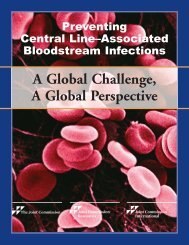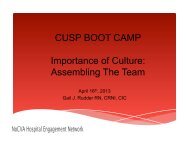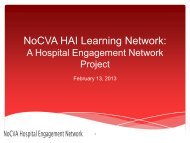Improving Surveillance for Ventilator-Associated Events in Adults
Improving Surveillance for Ventilator-Associated Events in Adults
Improving Surveillance for Ventilator-Associated Events in Adults
Create successful ePaper yourself
Turn your PDF publications into a flip-book with our unique Google optimized e-Paper software.
<strong>Improv<strong>in</strong>g</strong> <strong>Surveillance</strong> <strong>for</strong> <strong>Ventilator</strong>-<strong>Associated</strong> <strong>Events</strong> <strong>in</strong> <strong>Adults</strong><br />
Centers <strong>for</strong> Disease Control and Prevention (CDC)<br />
Overview and Proposed New Def<strong>in</strong>ition Algorithm<br />
What is the National Healthcare Safety Network (NHSN)<br />
• NHSN is the CDC’s healthcare-associated <strong>in</strong>fections (HAI) surveillance system (www.cdc.gov/nhsn). NHSN uses<br />
standard methodology and def<strong>in</strong>itions to collect data from U.S. healthcare facilities. More than 5000<br />
healthcare facilities <strong>in</strong> all 50 states now participate <strong>in</strong> NHSN. Most participat<strong>in</strong>g facilities report data on deviceassociated<br />
HAIs, <strong>in</strong>clud<strong>in</strong>g ventilator-associated pneumonia (VAP). Many states require hospitals to report HAIs<br />
us<strong>in</strong>g NHSN.<br />
How is VAP surveillance currently conducted <strong>in</strong> NHSN<br />
• NHSN’s current pneumonia (PNEU) def<strong>in</strong>itions were last updated <strong>in</strong> 2002, and were designed to be used <strong>for</strong><br />
surveillance of all healthcare-associated pneumonia events, <strong>in</strong>clud<strong>in</strong>g (but not limited to) VAP.<br />
• Three components make up the current PNEU def<strong>in</strong>itions: an “X-Ray” component (required), a “Signs and<br />
Symptoms” component (required), and a “Laboratory” component (optional).<br />
• VAP is specifically def<strong>in</strong>ed as a PNEU event that occurs at the time a ventilator is <strong>in</strong> place, or with<strong>in</strong> 48 hours<br />
after a ventilator has been <strong>in</strong> place. There is currently no required duration that the ventilator must be/have<br />
been <strong>in</strong> place <strong>for</strong> a PNEU to qualify as a VAP.<br />
Why is the CDC chang<strong>in</strong>g the way VAP surveillance is done <strong>in</strong> NHSN<br />
• The current PNEU def<strong>in</strong>itions are useful <strong>for</strong> <strong>in</strong>ternal quality improvement purposes, but are limited by their<br />
subjectivity and complexity. It is necessary to have objective, reliable surveillance def<strong>in</strong>itions <strong>for</strong> use <strong>in</strong> public<br />
report<strong>in</strong>g and <strong>in</strong>ter-facility comparisons of event rates and federal pay-<strong>for</strong>-report<strong>in</strong>g and -per<strong>for</strong>mance<br />
programs.<br />
What is the CDC’s process <strong>for</strong> improv<strong>in</strong>g NHSN VAP surveillance<br />
• The CDC’s Division of Healthcare Quality Promotion (DHQP) is collaborat<strong>in</strong>g with the CDC Prevention Epicenters<br />
(http://www.cdc.gov/hai/epicenters), the Critical Care Societies Collaborative (CCSC, http://ccsconl<strong>in</strong>e.org),<br />
other professional societies and subject matter experts, and federal partners.<br />
• DHQP <strong>in</strong>itiated a collaboration with the CCSC <strong>in</strong> September 2011, and convened a VAP <strong>Surveillance</strong> Def<strong>in</strong>ition<br />
Work<strong>in</strong>g Group, consist<strong>in</strong>g of representatives from several organizations with expertise <strong>in</strong> critical care,<br />
<strong>in</strong>fectious diseases, healthcare epidemiology and surveillance, and <strong>in</strong>fection control.<br />
Organization<br />
American Association of Critical-Care Nurses<br />
American Association <strong>for</strong> Respiratory Care<br />
American College of Chest Physicians<br />
American Thoracic Society<br />
Association of Professionals <strong>in</strong> Infection Control and Epidemiology<br />
Council of State and Territorial Epidemiologists<br />
HICPAC <strong>Surveillance</strong> Work<strong>in</strong>g Group<br />
Infectious Diseases Society of America<br />
Society <strong>for</strong> Healthcare Epidemiology of America<br />
Society of Critical Care Medic<strong>in</strong>e<br />
Representative(s)<br />
Ms. Suzanne Burns and Ms. Beth Hammer<br />
Dr. Dean Hess<br />
Drs. Robert Balk and David Gutterman<br />
Drs. Nicholas Hill and Mitchell Levy<br />
Ms. L<strong>in</strong>da Greene<br />
Ms. Carole VanAntwerpen<br />
Dr. Daniel Diekema<br />
Dr. Edward Septimus<br />
Dr. Michael Klompas<br />
Drs. Clif<strong>for</strong>d Deutschman, Mar<strong>in</strong> Kollef, and Pamela Lipsett<br />
• The Work<strong>in</strong>g Group recognized that there is currently no gold standard, valid, reliable def<strong>in</strong>ition <strong>for</strong> VAP. Even<br />
the most widely-used VAP def<strong>in</strong>itions are neither sensitive nor specific <strong>for</strong> VAP. There<strong>for</strong>e, the Work<strong>in</strong>g Group<br />
decided to pursue a different approach—development of a surveillance def<strong>in</strong>ition algorithm <strong>for</strong> detection of<br />
ventilator-associated events (VAEs). This algorithm will detect a broad range of conditions or complications<br />
occurr<strong>in</strong>g <strong>in</strong> mechanically-ventilated adult patients.<br />
• Because the reliability of HAI def<strong>in</strong>itions has become particularly important <strong>in</strong> recent years, the Work<strong>in</strong>g Group<br />
focused on def<strong>in</strong>ition criteria that use objective, cl<strong>in</strong>ical data that are expected to be readily available across<br />
the spectrum of mechanically-ventilated patients, <strong>in</strong>tensive care units and facilities—<strong>in</strong> other words, criteria<br />
that are less likely to be <strong>in</strong>fluenced by variability <strong>in</strong> resources, subjectivity, and cl<strong>in</strong>ical practices—and that are<br />
potentially amenable to electronic data capture.<br />
National Center <strong>for</strong> Emerg<strong>in</strong>g and Zoonotic Infectious Diseases<br />
Division of Healthcare Quality Promotion
NHSN <strong>Surveillance</strong> <strong>for</strong> <strong>Ventilator</strong>-<strong>Associated</strong> <strong>Events</strong> <strong>in</strong> <strong>Adults</strong><br />
What progress has the Work<strong>in</strong>g Group made<br />
• The Work<strong>in</strong>g Group has proposed a new surveillance def<strong>in</strong>ition algorithm to detect VAEs <strong>in</strong> adult patients. It is not<br />
designed <strong>for</strong> use <strong>in</strong> the cl<strong>in</strong>ical care of patients. The Work<strong>in</strong>g Group anticipates that the new def<strong>in</strong>ition algorithm<br />
will cont<strong>in</strong>ue to be ref<strong>in</strong>ed, based on the results of field experience and additional research. The def<strong>in</strong>ition<br />
algorithm ref<strong>in</strong>ement process is, and will cont<strong>in</strong>ue to be iterative, and will require the ongo<strong>in</strong>g engagement of the<br />
critical care, <strong>in</strong>fection prevention, <strong>in</strong>fectious diseases and healthcare epidemiology communities.<br />
What is the new, proposed NHSN surveillance def<strong>in</strong>ition algorithm<br />
• The def<strong>in</strong>ition algorithm (presented on page 3) is only <strong>for</strong> use with the follow<strong>in</strong>g patients:<br />
o Patients ≥ 18 years of age;<br />
o Patients who have been <strong>in</strong>tubated and mechanically ventilated <strong>for</strong> at least 3 calendar days; and<br />
o Patients <strong>in</strong> acute and long-term acute care hospitals and <strong>in</strong>patient rehabilitation facilities.<br />
• NOTE: Patients receiv<strong>in</strong>g rescue mechanical ventilation therapies (e.g., high-frequency ventilation, extracorporeal<br />
membrane oxygenation, or mechanical ventilation <strong>in</strong> the prone position) are excluded from surveillance us<strong>in</strong>g the<br />
new, proposed def<strong>in</strong>ition algorithm.<br />
How is the new surveillance def<strong>in</strong>ition algorithm different from the current PNEU def<strong>in</strong>itions<br />
• The new algorithm: 1) will detect ventilator-associated conditions and complications, <strong>in</strong>clud<strong>in</strong>g (but not necessarily<br />
limited to) VAP; 2) requires a m<strong>in</strong>imum period of time on the ventilator; 3) focuses on readily-available, objective<br />
cl<strong>in</strong>ical data; and 4) does not <strong>in</strong>clude chest radiograph f<strong>in</strong>d<strong>in</strong>gs.<br />
Why are chest radiographs not <strong>in</strong>cluded <strong>in</strong> the new surveillance def<strong>in</strong>ition algorithm<br />
• Evidence suggests that chest radiograph f<strong>in</strong>d<strong>in</strong>gs do not accurately identify patients with VAP. Furthermore, the<br />
variability <strong>in</strong> radiograph order<strong>in</strong>g practices, technique, <strong>in</strong>terpretation, and report<strong>in</strong>g make chest radiograph<br />
f<strong>in</strong>d<strong>in</strong>gs less well-suited <strong>for</strong> <strong>in</strong>clusion <strong>in</strong> an objective, reliable surveillance def<strong>in</strong>ition algorithm to be used <strong>for</strong> public<br />
report<strong>in</strong>g and <strong>in</strong>ter-facility comparisons of event rates and pay-<strong>for</strong>-report<strong>in</strong>g and -per<strong>for</strong>mance programs.<br />
How will I f<strong>in</strong>d cases us<strong>in</strong>g the new algorithm<br />
• CDC is work<strong>in</strong>g on operational guidance to help healthcare facility staff implement the new algorithm <strong>for</strong> electronic<br />
or manual event detection, once it is ready <strong>for</strong> deployment <strong>in</strong> NHSN. A possible method to make VAE surveillance<br />
more efficient is to organize data elements <strong>in</strong> a flow sheet at the patient’s bedside. In the example below, the<br />
shaded area highlights the period dur<strong>in</strong>g which a possible VAP event is detected.<br />
VentDay PEEPm<strong>in</strong> FiO 2 m<strong>in</strong> Tm<strong>in</strong> Tmax WBCm<strong>in</strong> WBCmax Antimicrobials Spec Polys Epis Organism<br />
1 10 60 37.9 38.1 12.1 14.2 None -- -- -- --<br />
2 5 40 37.1 37.5 11.8 11.8 None -- -- -- --<br />
3 5 40 36.9 37.6 12.1 12.1 None ETA ≥25/lpf
NHSN <strong>Surveillance</strong> <strong>for</strong> <strong>Ventilator</strong>-<strong>Associated</strong> <strong>Events</strong> <strong>in</strong> <strong>Adults</strong><br />
<strong>Surveillance</strong> Def<strong>in</strong>itions <strong>for</strong> <strong>Ventilator</strong>-<strong>Associated</strong> <strong>Events</strong>:<br />
• For use <strong>in</strong> acute and long-term acute care hospitals and <strong>in</strong>patient rehabilitation facilities.<br />
• For use <strong>in</strong> patients ≥ 18 years of age who are on mechanical ventilation <strong>for</strong> ≥3 calendar days.<br />
• NOTE: patients on rescue mechanical ventilation (e.g., HFV, ECMO, mechanical ventilation <strong>in</strong> prone position) are EXCLUDED.<br />
Patient has a basel<strong>in</strong>e period of stability or improvement on the ventilator, def<strong>in</strong>ed by ≥ 2 calendar days of stable or decreas<strong>in</strong>g FiO 2 or PEEP.<br />
Basel<strong>in</strong>e FiO 2 and PEEP are def<strong>in</strong>ed by the m<strong>in</strong>imum daily FiO 2 or PEEP measurement dur<strong>in</strong>g the period of stability or improvement.<br />
After a period of stability or improvement on the ventilator, the patient has at least one of the follow<strong>in</strong>g <strong>in</strong>dicators of worsen<strong>in</strong>g oxygenation:<br />
1) M<strong>in</strong>imum daily FiO 2 values <strong>in</strong>crease ≥ 0.20 (20 po<strong>in</strong>ts) over basel<strong>in</strong>e and rema<strong>in</strong> at or above that <strong>in</strong>creased level <strong>for</strong> ≥ 2 calendar days.<br />
2) M<strong>in</strong>imum daily PEEP values <strong>in</strong>crease ≥ 3 cmH 2 O over basel<strong>in</strong>e and rema<strong>in</strong> at or above that <strong>in</strong>creased level <strong>for</strong> ≥ 2 calendar days.<br />
<strong>Ventilator</strong>-<strong>Associated</strong> Condition (VAC)<br />
Public Report<strong>in</strong>g Def<strong>in</strong>ition<br />
On or after calendar day 3 of mechanical ventilation and with<strong>in</strong> 2 calendar days be<strong>for</strong>e or after the onset of worsen<strong>in</strong>g oxygenation, the<br />
patient meets both of the follow<strong>in</strong>g criteria:<br />
1) Temperature > 38 °C or < 36°C, OR white blood cell count ≥ 12,000 cells/mm 3 or ≤ 4,000 cells/mm 3 .<br />
AND<br />
2) A new antimicrobial agent(s) is started, and is cont<strong>in</strong>ued <strong>for</strong> ≥ 4 calendar days.<br />
Infection-related <strong>Ventilator</strong>-<strong>Associated</strong> Complication (IVAC)<br />
Public Report<strong>in</strong>g Def<strong>in</strong>ition<br />
On or after calendar day 3 of mechanical ventilation and with<strong>in</strong> 2<br />
calendar days be<strong>for</strong>e or after the onset of worsen<strong>in</strong>g oxygenation,<br />
ONE of the follow<strong>in</strong>g criteria is met:<br />
1) Purulent respiratory secretions (from one or more specimen<br />
collections)<br />
• Def<strong>in</strong>ed as secretions from the lungs, bronchi, or trachea that<br />
conta<strong>in</strong> >25 neutrophils and





